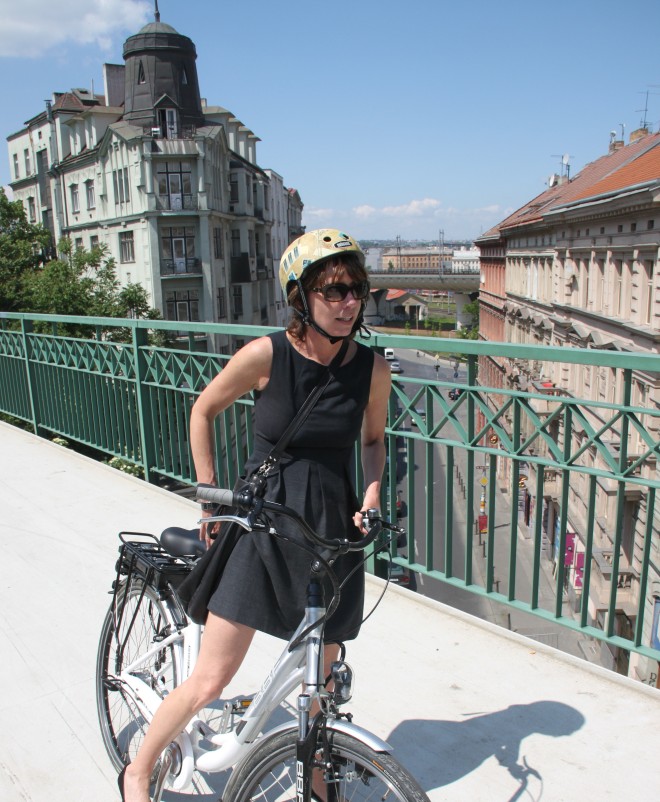
Janette Sadik-Khan: North America's Bicycle Super Star: Velo-city Talk
In under two weeks, ECF will be leaving for Velo-city Global in Vancouver. Before we go to the North American continent, we thought we should have a chat with Janette Sadik-Khan, New York's Transport Commissioner. ECF board member Daniel Mourek had the chance to interview her when she was visiting Prague last month.
Q: How did it happen that you found yourself in position of Commissioner of Transport in NYC, managing 5.000 employees?
Mayor Bloomberg hired me as New York City’s transportation commissioner in April 2007. That spring, the Mayor also introduced an ambitious sustainability agenda, PlaNYC, which put the city on a path to a greener, greater future.
Q: What are the biggest challenges in your work?
One of the biggest challenges that New York City—and almost every city around the globe— faces is doing more with less. Today, people and jobs can move anywhere, so every city grapples with the push to provide a high quality of life high, while keeping costs low.
"Every city grapples with the push to provide a high quality of life high, while keeping costs low"
In New York City, we have learned to be creative in our approach to delivering safer streets that work better and are more inviting for everyone. We use treatments such as epoxy gravel, granite blocks and concrete planters to create plazas and extend sidewalks that give people more room to walk, sit and enjoy their streetscapes. We use paint, thermoplastic markings and signs to install bike lanes, which not only give bicyclists dedicated space for a more comfortable ride, we also found that streets with bike lanes are 40% less deadly for pedestrians.
Another challenge is helping people to understand why these changes are needed and to get them to participate in the process. New Yorkers think of their streets as extensions of their homes and front yards. So while these places are public, shared spaces, they are also very familiar and personal. This is why DOT is very focuses on education and outreach, sponsoring workshops and other community meetings for projects ranging from our NYC Plaza Program (our citywide neighborhood plaza program) to locations for bike share stations and Select Bus Service (New York City’s version of bus rapid transit) stops to our and community-requested safety initiatives such as DOT’s new 20 m.p.h. Neighborhood Slow Zone initiative, which creates several blocks of traffic-calming in residential neighborhoods throughout the city.
"We also found that streets with bike lanes are 40% less deadly for pedestrians"
Q: What is your most recent success story on cycle agenda in NYC?
Citi Bike, New York City’s bike share system, is 2 months away from officially launching. The first bikes will be available at the end of July. It is an exciting time for transportation, as we roll out this new program that complements and extends the reach of the city’s bus and subway network.
Q: What manuals are you using in your daily work?
PlaNYC, Mayor Bloomberg’s sustainability agenda, and DOT’s strategic plan, Sustainable Streets, are two resources that we turn to again and again. Taken together, they are the blueprint for engineering a safer, sustainable New York City, and we’re making tremendous progress. And while these action plans allow us to benchmark our progress towards our goals to improve safety, reduce the City’s carbon footprint and make sustainable transportation options more attractive and effective, these are also living documents that we can continue to add to as we look to improve the quality of life for the more than 8 million New Yorkers today, and the one million more New Yorkers we expect by 2030.
Q: What is the vision of NYC based on and what is role of cycling/ped transport in this vision? How is it funded?
PlaNYC emphasizes the intricate connection between sustainable growth—and the role the city’s design will play—and New York City’s future success. It essentially creates a roadmap for managing the growth of the city. A big part of engineering a greener, greater New York City is improving our streets so they encourage people to walk and bicycle more. Funding for the PlaNYC initiatives was included in the Mayor’s budget.
Importantly, safety and sustainability go hand in hand. In the past five years, we invested in comprehensive safety projects to redesign streets so they are safer for everyone, whether they are walking, biking or driving. This focus on safety has delivered impressive results, with the last four years being the safest in the City’s more than 100 years of record-keeping. Still, we will continue working harder than ever—redesigning other traffic hotspots so traffic flows smoother and streets are safer—for everyone using them. An important component of this work is the fact that federal government clean-air funds pay for 80% of the cost of our bike projects, which are actually the anchors for projects that make streets safer for pedestrians and motorists as well as for bike riders.
"A big part of engineering a greener, greater New York City is improving our streets so they encourage people to walk and bicycle more"
We also continue to introduce new initiatives that make our streetscapes more inviting for walking. We launched the CityBench program, which installs sleek, comfortable public benches at transit hubs and commercial corridors to encourage walking by giving people places to rest in between destinations. We also are gearing up for the launch of our way finding program. This will create standardized signage and establish walking maps for several New York City neighborhoods that will make it easier to navigate to key area attractions and transit.
Our new bike share program also will provide an attractive option for getting around quickly, efficiently and cost-effectively, and with all the costs of implementation being paid for by the sponsor and not by New Yorkers.
Mayor Bloomberg Announces New York's Bike Share System.
Q: Is there something you would recommend to be implemented in Prague from what you have done in your city or what you have seen in Prague?
Prague has an historic, dense urban center that is well served by subway and a streetcar network that many cities would covet. The challenge is linking all of its neighborhoods into this network. In New York, we’re expanding Select Bus Service throughout the city and I think you have a great opportunity to create a radial transport network to get people into the City on more sustainable forms of transportation. This could be done through a light-rail or Bus Rapid Transit service and reduce the number of cars entering the central business district of Prague.
We’re also launching the largest bike share program in North America which is fully paid for by sponsors in the private sector, will provide New Yorkers a healthy, affordable, greener way to travel around the city. A similar program could transform travel in Prague, which remains a fairly compact city.
Sadik-Khan talks about her work in New York.
Providing better walking options for New Yorkers is another important part of our strategy, and we’re building 50 new plazas throughout the City. Transforming the way people think about and use streets does not need to take years of construction or a big budget. Cities can create the positive changes they want to see with the tools and resources already on hand, and with willing partners, so it is important to explore various public-private partnerships. Our bike share model, our relationships with local communities and organizations as plaza partners, and the progress we are making to introduce new bus rapid transit lines with MTA/New York City Transit—these are solutions that provide transit service and improve the public realm for thousands of New Yorkers without spending billions of dollars. Prague, like many cities around the world without unlimited budgets can look to these.
Q: What makes you like NYC as place for living and working?
New York City is a world-class city, and its diversity and density mean that almost anything imaginable is within reach. Unparalleled shopping, dining, museums, entertainment and other types of cultural attractions coupled with the choicest parks, plazas and waterfront in the world. It is all here. What’s more, most destinations are easily accessible by walking, biking, taking a bus, train—and increasingly, ferry—or a combination of those things.
It’s the chemistry of this city—the mixture of things to do and experience, and the convenience that this city’s transportation network affords—that makes New York City unlike any other place in the world. And our city, under the leadership of Mayor Bloomberg, will only continue to get better as city agencies continue making steady progress on the goals outlined in PlaNYC.
About Janette Sadik Khan
Janette Sadik-Khan is the current Commissioner of the New York City Department of Transportation, appointed by New York City Mayor Michael Bloomberg in 2007. Sadik-Khan has been a key player in Mayor Michael Bloomberg’s efforts to transform New York into a green city under PlaNYC by reducing the city’s carbon footprint 30% by the year 2030. She's also installed over 250 miles of on-street bike lanes, car-free summer streets, weekend pedestrian walks and a new Street Design Manual
Why the interest in North America?
ECF is not just interested in cycling in Europe. We think it’s important to take a global perspective. So much so that our next big conference, Velo-city Global 2012, is taking place in Vancouver in June (26-29). It’s the biggest cycling planning conference in the world, bringing together the best and the brightest in cycling and transport policy. Check out the conference website here, and register now. It’s going to be a great event.
Contact the author
Recent news!
Upcoming events
Contact Us
Avenue des Arts, 7-8
Postal address: Rue de la Charité, 22
1210 Brussels, Belgium












